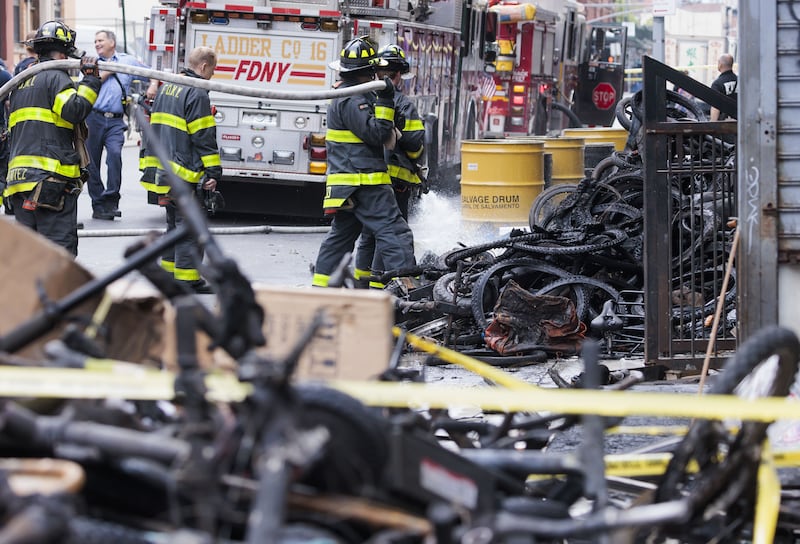The batteries used to power electric scooters and bikes are “the fastest growing fire trend internationally”, according to Dublin Fire Brigade (DFB), which has warned they can be “explosive with shooting flames” when faulty, improperly fitted or used without proper attention.
The service says the number of reported incidents to date has been low but warns against leaving them unattended, charging them while asleep or leaving them plugged in after they become fully charged and says when things go wrong they have the potential to cause serious fires “in a matter of seconds”.
The union representing DFB members said it would like to see a comprehensive plan developed by the organisation to train and equip its own firefighters to deal with issue.
Siptu official Geoff McEvoy says more needs to be done to assess the risks involved and to mitigate them. “I think the there’s a constant race to keep up with new developments when it comes to technology on the one hand and fire safety on the other,” he says. “We’re seeing that dynamic again in relation to issues with batteries in electric vehicles, be they cars or smaller vehicles like scooters.
READ MORE
“The concern that we have is that there isn’t, as far as we’re aware at the moment, a training plan or new equipment being provided to respond to the new risks posed by these vehicles and these batteries.”
DFB denies training or equipment is an issue although it is understood the fire brigade does not have the specialised equipment specifically to deal with fires in electric cars.
Such fires occur far less commonly than in traditional combustion engines, research suggests, but pose far greater challenges due to the speed and intensity with which the batteries burn. Huge volumes of water are required to extinguish them – 100,000 litres or more compared to perhaps 1,500 litres (a typical fire appliance carries 1,800) – because of the casing around the batteries.
In some parts of Europe there has been a move towards the use of devices that pierce the casing then get water directly into the battery. The vehicle is often removed afterwards and partially submerged in water so as to guard against the significant risk of reignition.
Internationally, though, the batteries in smaller devices, generally charged in homes, often in common areas in multi-occupancy developments, are emerging as a more immediate and pressing concern.
New batteries, sold with the device they are intended to power and meeting EU standards, are considered safe when used properly, but present a risk if over-charged, short-circuited, submerged in water or damaged in any way, according to the Department of Enterprise. “Retrofitting of e-bike and e-scooter lithium-ion batteries and chargers can increase safety risks, particularly if using cheaper online-available batteries and chargers which are not compatible with the e-bike or e-scooter,” it says.
The number of incidents faulty or improperly used batteries are responsible for in Ireland is impossible to accurately quantify because although just 225 of more than 11,000 fires attended by fire brigades in 2022 were attributed to electrical devices of any sort, there was no known cause established in more than half of all incidents, 57 per cent.
[ Are electric cars a greater fire hazard than petrol or diesel powered ones?Opens in new window ]
If there is some uncertainty here about the scale of the problem in Ireland, though, fire brigades with larger catchment areas abroad are clearer about the trend.
A Channel 4 News report at the end of September asked fire brigades about the issue, and those that responded were reported as ascribing some 550 fires to lithium-ion batteries in recent years. Their figures showed a steady year-on-year increase in the numbers of fires the batteries were responsible for. These fires were said to pose particular challenges such as resistance to water and burning with particular ferocity.
Figures obtained by insurance firm Zurich and issued by the Chartered Trading Standards Institute in the UK in February suggested the number of household fires caused by the batteries had increased by 150 per cent in a year.
On November 14th the New York City Fire Department said a lithium-ion battery had been responsible for starting a Brooklyn fire in which three people died. At that point it said there had been 238 fires this year started by such batteries, with 17 fatalities. On December 18th, it told The Irish Times the figures at that point were 258 and 18 respectively.

The city’s fire commissioner has described the batteries as “ticking time bombs” in people’s homes.
One Dublin fire attributed to lithium-ion batteries occurred at a block of apartments on Francis Street in August. All of the residents had to be evacuated, some from a roof terrace, by units of the fire brigade, and evidence indicated the blaze had been started by batteries on one floor, after which it moved up through the building and ignited another battery on a higher floor.
The batteries were in public areas, a common occurrence, it is suggested, because of the free electricity, but a particular safety problem when fires do break out.
DFB says more research needs to be done on the extent of the issue but says it does not have statistics in relation to Dublin, something McEvoy says has long been highlighted as a problem here. It is understood much record-keeping is still paper-based pending the introduction of a long-awaited computerised system.
“These technologies are developing so fast that fire services internationally are constantly playing catch-up, and Dublin Fire brigade is no different,” says senior firefighter John Chubb, who headed up the DFB’s risk unit.
“The increased number of people out on the roads even compared to two years ago, either in EVs or on scooters, I think has caught most brigades out.”
When a fire occurs in an EV, he says, “you have the issue of how you put it out, how to make the vehicle safe and what are you going to do with all of the water which now contains cobalt and a cocktail of other chemicals and so is a hazard”.
“And what happens if the car was in an underground car park where other cars might catch fire because the first vehicle burns with such intensity? And later a recovery vehicle can’t get in.”
Dublin Fire Brigade says it has requested that all new car parks in apartment buildings should be fitted with a sprinkler system, but the point, Chubb says, is that it is not just fire brigades that need to think about how the hugely increased use of battery devices is going to have to be addressed; the planners, regulators and builders have some catching up to do too.
- Sign up for push alerts and have the best news, analysis and comment delivered directly to your phone
- Find The Irish Times on WhatsApp and stay up to date
- Our In The News podcast is now published daily – Find the latest episode here


















